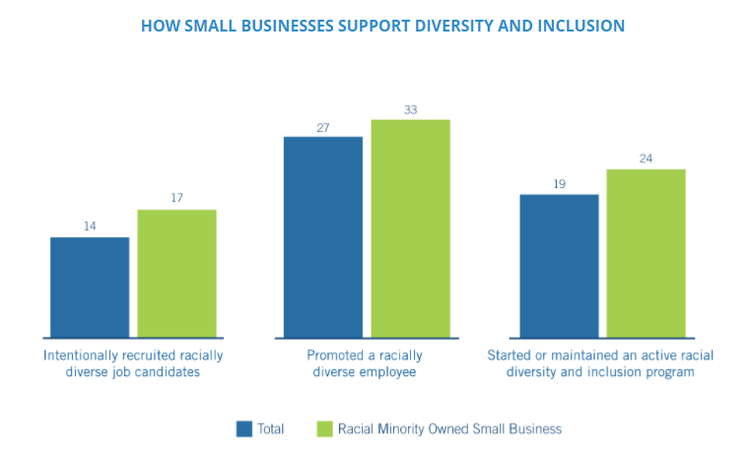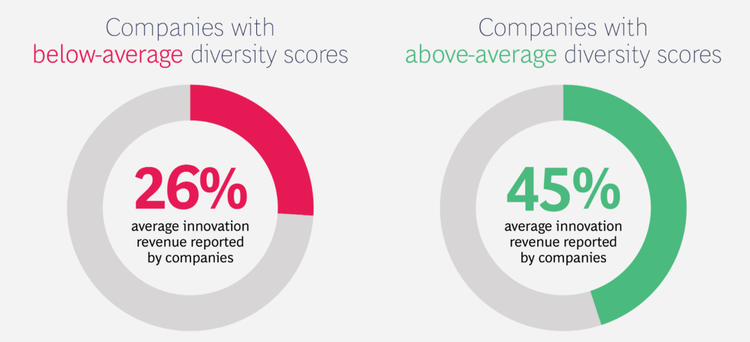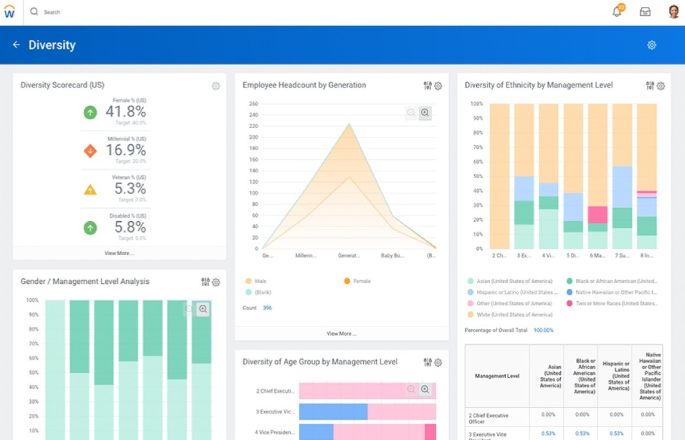Diversity Management for Small Businesses
"We don't get a lot of diverse applicants."
"We're color blind. We just hire the most qualified candidate for each spot."
"There aren't a lot of diverse candidates in our industry/area."
I've heard comments like these from many small business owners who want to increase diversity in the workplace. To be fair, it’s challenging to tap into a rich, diverse candidate pool. Failing to do so, however, holds your business back.
One major stumbling block to achieving workplace diversity is the notion that people shouldn't be put into boxes based on their identities. Isn't that the very thing we're trying to avoid?
Pew researchers found that most Americans value diversity in business, but balk at making hiring or promotion decisions based on factors such as race or sex.
A recent survey by MetLife and the U.S. Chamber of Commerce uncovered a similar disconnect. The survey showed that most small business owners believe hiring minorities should be a priority, yet only 14% had intentionally recruited an ethnically and racially diverse candidate over the prior year.
For minority-owned businesses, that number jumped to only 17%. These data suggest a major opportunity and a clear solution for business leaders who want to improve their diversity and inclusion (D&I) practices.

Graph showing diversity and inclusion initiatives by small businesses. Image source: Author
Overview: What is diversity management?
Diversity management is the effort to recruit and maintain a diverse, inclusive workforce. This includes diversity in factors such as race, ethnicity, gender, age, ability, religion, sexual orientation, and culture. It can also include factors such as military service, education, and socioeconomic status.
You may be looking for ways to improve diversity in your workplace because you feel it's the right thing to do, as most businesses in the Chamber survey clearly believed. But the benefits of diversity go far deeper.
Diversity in organizations enhances employee retention, customer relations, and employee engagement. Managing diversity also improves financial performance.
Numerous studies confirm the competitive advantages of a diverse environment across various organization types and industries.
A study by Boston Consulting Group (BCG) found that diverse companies generate nearly twice as much innovation revenue, the share of revenue from new products, as their less diverse peers.

Diversity boosts innovation revenue substantially. Image source: Author
Another example is research by McKinsey& Company showing that the likelihood of outstanding financial performance is:
- 21% higher for companies with gender-diverse executive teams
- 33% higher for companies with ethnically and culturally diverse executive teams
- 29% lower for companies lacking diversity
Yet despite the obvious benefits, McKinsey reports that women make up just 20% of executive teams worldwide (19% in the United States), and ethnic representation is lower yet, at 15%.
It's pretty telling that women are still wrangling for one out of five seats at the executive table, and that ethnically diverse leadership lags even further. The fact that women make up half of the population and 56% of U.S. college graduates also blows a bit of a hole through the "there aren't any in the pipeline" argument.
Clearly there's plenty of room for improvement, and companies have good reasons to pursue it.
Diversity management and discrimination: a word of caution
Title VII of the Civil Rights Act of 1964 (Title VII) bars employers from deciding based on race, sex, and other traits protected by the law. This puts employers in a bit of a Catch-22. Hire diverse candidates, but don't consider diversity when hiring.
The Equal Employment Opportunity Commission (EEOC) generally allows diversity plans that address a clear disparity. To avoid charges of discrimination, make a habit of connecting every diversity goal to a measured disparity.
You can do this by including a "to correct" statement in your diversity goals. For example, "To correct a lack of representation by women in our executive team, we will improve gender diversity from 8% to 20% by 2021."
Another concern to remember is that the EEOC generally rejects quotas and other "mechanical plus factors." To avoid problems, write your diversity goals in broad strokes across operating areas or departments and speak to percentages, not numbers.
For example, "increasing racial diversity by 30% in operations" is okay, but "hiring two women in sales in 2020" is a quota. Adding 5 points to a candidate score card for each diverse characteristic also won't fly.
You can promote diversity and stay on the right side of the law by observing these hiring best practices:
- Keep diversity goals general, addressing broad segments of your company
- Avoid specific quotas or mechanical rating systems for weighting diverse traits
- Never make diversity the deciding factor in any employment decision
- Consider identity only in a candidate's total qualifications
- Focus on diversifying your pipeline rather than trying to tip the scales with existing candidates to correct diversity gaps
7 best practices for implementing diversity management into your business
So how can you move past good intentions to actions to create a more inclusive environment in your company? These best practices will help you get there.
1. Commit to diversity
Look at your company's core plans, policies, and documents. You probably covered diversity in your employee handbook, orientation training, and human resources (HR) plans. Beyond that, does it fall off the radar?
An inclusive workplace starts from the top down. You can begin by writing it into key corporate documents such as:
- Your company's mission statement, vision, and values
- Strategic plans and objectives
- Operational plans and performance goals
When you think of diversity as a driver of financial performance, it makes sense to tie it to your company's high-level strategies and goals.
2. Create measurable diversity goals
Companies that outpace the competition in diversity do so intentionally with measurable performance goals. For example, say your executive team has 12 members, including two women and one person of color. Your team is 16% gender diverse and 8% racially diverse.
Looking at benchmarks, you're about 8 points below the average in gender and racial diversity. But do you want to benchmark by averages when they fall so far short of representation? Why not aim for parity based on how well your teams reflect the population?
Measured against the U.S. population, you have a gap of about 38% in gender diversity and 10% in racial diversity. You can gauge representation more precisely based on your industry and location.
Examples of measurable diversity goals would be:
- "To address a 38% gap in gender equity in our company, we will increase diversity at the executive level to 30% by Q4."
- "To correct a 10% gap in racial diversity of front-line managers, we will increase representation to 20% in 2020."
3. Connect goals to company performance
Like other operational goals, your diversity goals should connect up to company performance. You can do this by applying data from diversity studies.
For example, the BCG study found that a 2% increase in diversity within a management team improves innovation revenue by 1%.
By connecting diversity to performance, you can verify the return on your efforts and allocate resources appropriately.

Workday is an outstanding HR software with a diversity dashboard to track your progress. Image source: Author
4. Provide diversity training
Training is critical to a successful diversity management effort. Your training needs to begin with deep-seated attitudes and assumptions about the value of diversity and how it can be measured and improved. It also requires tackling potentially divisive topics such as making HR decisions based on factors such as race or sex.
Carefully-guided discussions can help build consensus and buy-in among your entire workforce, which is critical to the success of your diversity management program.
Besides all-employee training on diversity, you'll need hands-on training for supervisors, managers, and executive teams. Your training should:
- Provide specific guidance about your diversity goals and how you plan to achieve them
- Connect the dots between your company's diversity and performance
- Include role-playing exercises to help managers work through potential conflicts and challenges
5. Pursue diverse candidates
If you can't hire specifically for diverse characteristics, how do you move the needle on diversity? By enriching your recruiting efforts to actively seek candidates with varied backgrounds.
If you're not getting any fish in your usual fishing hole, move the boat. Move it all the way across the lake if you have to until you see diverse candidates flowing in.
There's no law against teaming up with your community college system to train promising students. There's no law against offering internships through schools with diverse populations.
You can safely recruit at conferences or associations devoted to women, or to people of color, or to people with disabilities, or to veterans' organizations. These organizations are actively seeking opportunities to team up with businesses like yours.
If you fill the pipeline with a wider range of candidates, you can achieve inclusion without hiring people specifically to fill a diversity quota.
6. Develop good people
Another key piece of diversity management is promoting diverse employees into leadership positions. Once again, this isn't about pushing certain classes of employees up the ladder. It's about making good decisions to give a wider range of employees an equal chance to climb it.
With a clear mandate from company leadership and ample training, managers are less likely to default to promoting people who look or act or think just like them. Sometimes, you have to give strong direction to help managers overcome ingrained thinking and habits.
When they do, your company will really begin to see the benefits of its diverse talent. As your business gets better at developing its existing talent, you'll also see the benefits in reduced turnover.
7. Track results and adjust
Like any other strategic initiative, diversity management is an ongoing effort of tracking results and adjusting course as needed.
HR software such as Workday can measure, track, and report on diversity for you. Workday has excellent tools for managing diversity, including a diversity dashboard that gives you real-time stats on the makeup of your workforce.
The company has also earned the #7 spot on Fortune's "Best Workplaces for Diversity." Maybe that's part of the reason Workday has risen to the top in a highly competitive, innovative industry.
Cultivate growth
The word "culture" shares its root with "cultivate." Cultures and communities are the medium in which businesses grow.
Connecting your workforce with its diverse community of customers, vendors, partners, and neighbors will naturally help your business thrive and grow far beyond anything you could have imagined on your own.
Alert: our top-rated cash back card now has 0% intro APR until 2025
This credit card is not just good – it’s so exceptional that our experts use it personally. It features a lengthy 0% intro APR period, a cash back rate of up to 5%, and all somehow for no annual fee! Click here to read our full review for free and apply in just 2 minutes.
Our Research Expert
We're firm believers in the Golden Rule, which is why editorial opinions are ours alone and have not been previously reviewed, approved, or endorsed by included advertisers. The Ascent does not cover all offers on the market. Editorial content from The Ascent is separate from The Motley Fool editorial content and is created by a different analyst team.
Related Articles
View All Articles